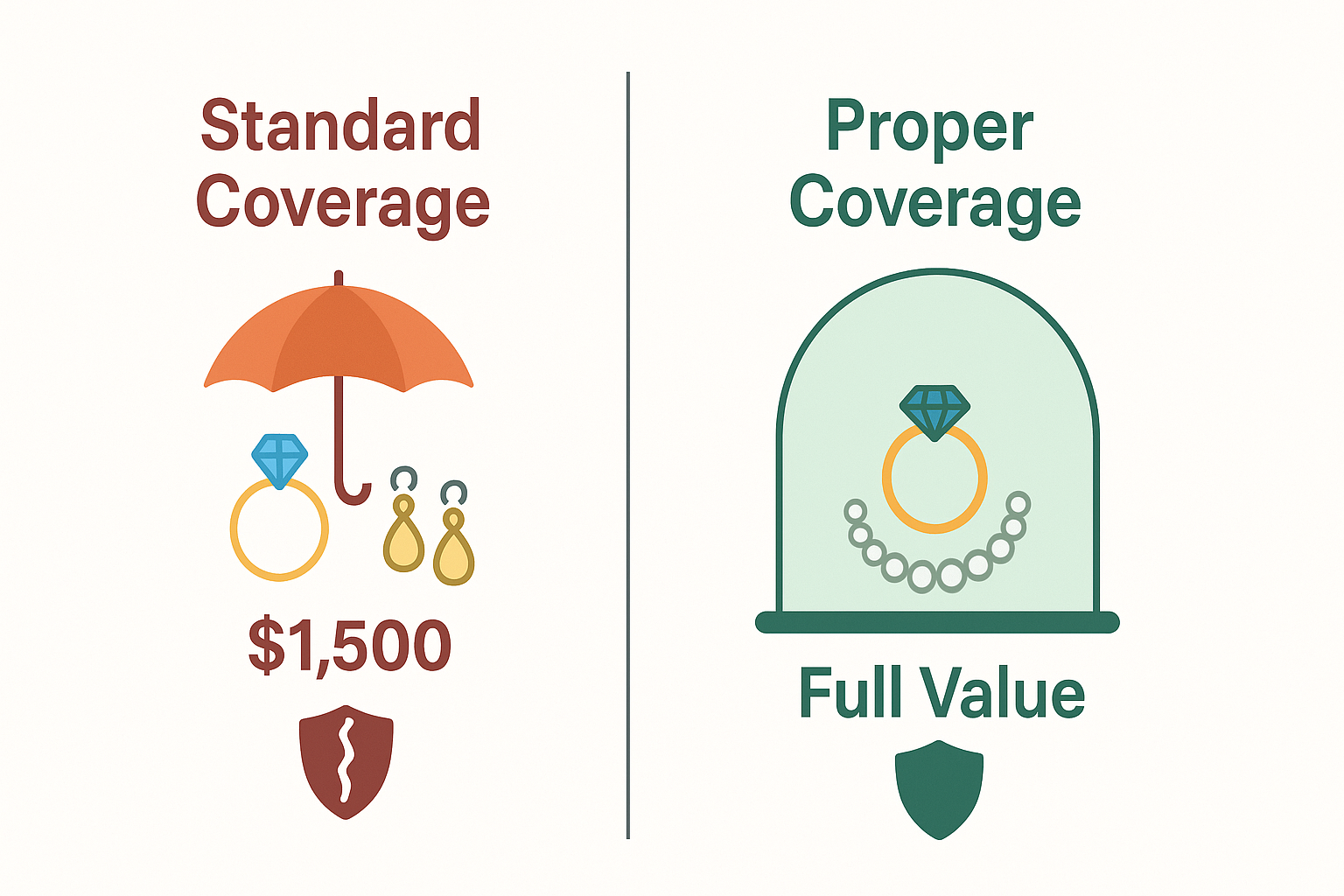







You’ve just inherited your grandmother’s diamond ring worth $15,000, or perhaps you’ve purchased an engagement ring that cost more than your car payment. Now you’re wondering: does my homeowner’s policy cover expensive jewelry? The answer is yes, but with significant limitations that could leave you financially vulnerable if you don’t understand the gaps in coverage.
Understanding exactly what your current homeowner’s insurance policy covers for expensive jewelry and where it falls short is crucial for protecting these valuable assets.

Your home insurance does include jewelry as personal property, but the protection comes with severe restrictions. Most standard homeowner’s insurance policies treat jewelry with significant limitations that catch many policyholders off guard.
Important: Even if your property insurance covers $100,000 in personal belongings, jewelry theft is typically capped at just $1,500 to $2,500 total—regardless of your jewelry’s actual value.
The biggest limitation is the dollar amount. Even if your property insurance covers $100,000 in personal belongings, jewelry theft is typically capped at just $1,500 to $2,500 total across major insurers. This means your $8,000 engagement ring would only receive $1,500 in compensation if stolen, regardless of your jewelry’s actual value.
Beyond low reimbursement limits, homeowner’s policy limitations also extend to the types of losses covered. Many policies exclude some types of losses which accounts for most jewelry claims.
Understanding what’s excluded from your property insurance is just as important as knowing what’s covered. These common exclusions can leave you financially exposed when you least expect it:
• Mysterious Disappearance: When jewelry simply goes missing without explanation
• Accidental Loss: Dropping jewelry down a drain, losing it at the beach, or leaving it in a hotel room
• Wear and Tear: Normal damage from daily use, loose prongs, or worn clasps
• Negligence: Damage or loss due to carelessness or inadequate security
• Natural Disasters: Floods and earthquakes typically require separate coverage
These exclusions mean that even if your expensive jewelry is worth less than your policy’s limits, you might still face a denied claim depending on how the loss occurred.
Warning: “Mysterious disappearance” accounts for 80% of jewelry claims, yet most homeowner’s policies exclude it entirely.

A scheduled personal property endorsement is often the most cost-effective solution for homeowners. This endorsement adds specific jewelry items to your existing homeowner’s insurance policy with full replacement value coverage. It provides broader protection including mysterious disappearance, worldwide coverage, and agreed-upon value with no deductible.
Cost Breakdown: Scheduled jewelry coverage typically costs 1-2% of the item’s appraised value annually. A $10,000 ring = $100-200 per year.
Standalone jewelry insurance from specialized companies offers comprehensive coverage specifically designed for valuable jewelry, completely separate from your home insurance. The major advantage is that claims don’t affect your homeowner’s insurance rates or renewability, making it ideal for very expensive pieces.
You can also increase the standard jewelry coverage limit on your homeowner’s policy from $1,500 to $5,000 or $10,000. However, this option still leaves you with the same exclusions and per-item limits, making it less comprehensive than the other options.
Q. Can I insure jewelry I inherited without an original receipt?
A. Yes, you can insure inherited jewelry without a receipt. Insurance companies accept professional appraisals as proof of value for inherited pieces. The appraisal will establish current market value regardless of when or where the jewelry was originally purchased.
Q. Will filing a jewelry claim increase my homeowner’s insurance premiums?
A. Filing a claim under your homeowner’s policy can potentially affect your premiums and renewability. This is one reason why standalone jewelry insurance is attractive for expensive pieces—claims don’t impact your home insurance rates.
Q. How often do I need to update my jewelry appraisal?
A. Most insurance companies require appraisal updates every 2-3 years to account for market value changes. Some policies may require annual updates for very expensive pieces. Check with your insurer about their specific requirements.
Q. What documentation do I need to file a jewelry insurance claim?
A. You’ll typically need your insurance policy, the original appraisal, photos of the jewelry, a police report (for theft), and any relevant receipts. Having detailed documentation makes the claims process much smoother.
Don’t wait until it’s too late to properly insure your expensive jewelry. The gap between what your homeowner’s insurance policy covers and your jewelry’s actual value could cost you thousands if loss or theft occurs.
AppraiseItNow provides fast, certified appraisal services for property, equipment, real estate, and businesses. Our certified appraisers understand exactly what insurance companies require for jewelry coverage, ensuring your appraisal will be accepted and your coverage will be reliable. Contact AppraiseItNow today to get the professional appraisal you need to properly protect your valuable jewelry investment.




